The Making of Airbnb
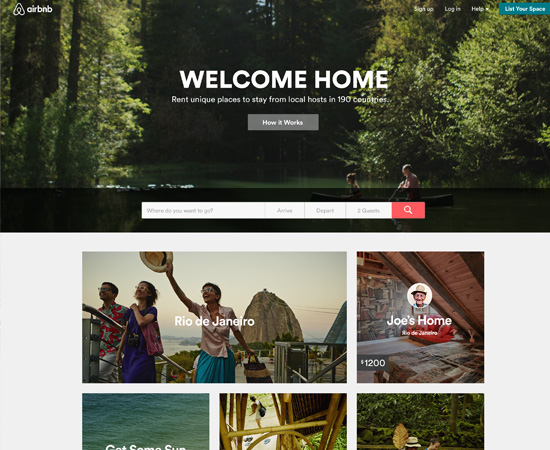
By Morgan Brown
Shortly before Thanksgiving of 2015, it was announced that Airbnb had raised $100 million at a valuation of $25.5 billion. That $100 million was a drop in the bucket compared to the war chest of $1.5 billion the company raised earlier in the summer, raised on the back of increasingly strong growth. The company reported revenues in the third quarter of 2015 at $340 million, on track for just shy of $1 billion in total revenue for the year. Nights booked, the company’s metric of choice, continues to see incredible year over year growth, estimated at the time of the announcement to hit 78 million nights in 2015, nearly double their 2014 bookings.
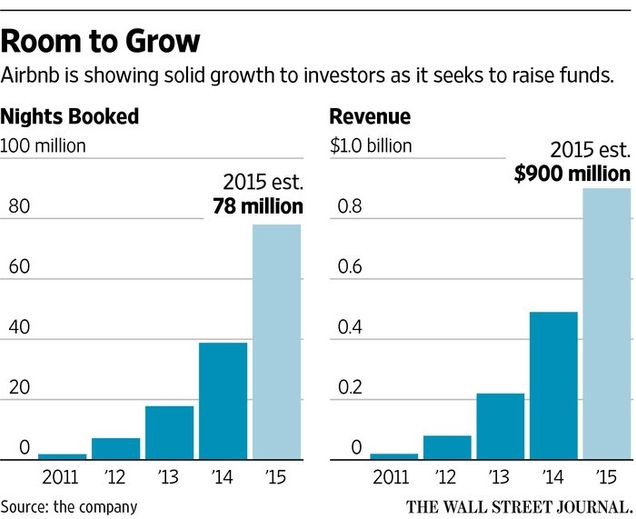
Firmly atop the unicorn heap–the Silicon Valley slang for companies worth more than $1 billion in private valuation–Airbnb has turned itself into an international brand to be reckoned with, and only its own stumbles or government regulation seem to stand in its way on the path to long-term success.
Over the last two years I’ve spent thousands of hours dissecting what makes companies like Airbnb tick, and how they, among all others, found breakthrough success. What I’ve found in them all is an organizational DNA imbued with a singular passion for driving growth. While Airbnb works hard at it’s brand image, success at the company is driven by calculating, relentless focus, and an internal growth culture that drives it’s stratospheric performance in a systematic way.
While we all love to tell stories of “once in a generation” ideas that succeed on their own merits, the truth is always messier. A business idea that seems like it was destined for success from the get-go, Airbnb was far from certain in the early days, with failure not further than a few boxes of cereal away at any moment. (Keep reading.) Flush with cash and Chip Conley’s culture infusion, the company today likes to talk more about brand and experience, but underneath, a driven team focused on growth continues to spur the company forward.
The Beginning of Airbnb
In 2007, designers Brian Chesky and Joe Gebbia couldn’t afford the rent on their San Francisco apartment. To make ends meet, they decided to turn their loft into a lodging space, but, as Gebbia explains, “We didn’t want to post on Craigslist because we felt it was too impersonal. Our entrepreneur instinct said ‘build your own site.’ So we did.”[1]
There was a design conference coming to town and hotel space was limited, so they set up a simple website with pictures of their loft-turned-lodging space—complete with three air mattresses on the floor and the promise of a home-cooked breakfast in the morning. This site got them their first three renters, each one paying $80, and after that first weekend they began receiving emails from people around the world asking when the site would be available for destinations like Buenos Aires, London, and Japan. Gebbia explains, “People told us what they wanted, so we set off to create it for them. Ultimately while solving our own problem, we were solving someone else’s problem too.” [1]
The following spring, they enlisted their former roommate, Nathan Blecharczyk, to help them get Airbed & Breakfast off the ground. Fast forward eight years, and Airbed and Breakfast is now Airbnb—a household name that has surpassed industry stalwarts like Hilton Hotels in nights booked. But how did a few air mattresses on the floor become the most widely-used anecdote for breakout startup growth?
Early Growth from Pure Hustle
As they were starting out, the founders needed a way to raise money. In an ingenious move that would soon be a hallmark of their creativity, they bought a ton of cereal and designed special edition election-themed boxes—Obama O’s and Cap’n McCain’s. They sold 500 boxes of each cereal, helping them to raise around $30k for their new venture.

Still, the Airbnb idea did not gain much traction, and the founders resorted to living off of leftover Cap’n McCain’s (the Obama O’s sold out)—a time they refer to as a real “low point.” The following spring they had dinner with Paul Graham, the founder of prestigious Silicon Valley incubator Y-Combinator. The incubator is a veritable hit factory, backing companies such as Reddit, Dropbox, Stripe and others. Despite recognizing the startup’s potential, Graham admits to having his doubts, explaining “I thought the idea was crazy. … Are people really going to do this? I would never do this.”[4] Nevertheless, Airbed & Breakfast soon joined Y Combinator’s 2009 winter class. [2]
It wasn’t just Airbnb’s business model that posed a concern. When Gebbia and Chesky—both of whom are Rhode Island School of Design alums—were initially seeking funding for their startup, investors didn’t know what to make of a company with two designers.[4] Yet it was most likely this design background that helped Airbnb to find such innovative, unexpected solutions, an ability that informs much of Airbnb’s growth strategy today.
Breaking Out: Craigslist and the Makings of Silicon Valley Legend
It’s unclear exactly when Airbnb implemented what’s become their most infamous growth strategy, a long-since-abandoned (unauthorized) integration with Craigslist that unlocked a torrent of free users, but there is evidence of the strategy starting as early as 2010. [6] Though the startup worked hard to distinguish themselves from the more impersonal super platform, Craigslist had one thing that Airbnb did not—a massive user base. Airbnb knew that Craigslist was the place where people who wanted something other than the standard hotel experience looked for listings.
In order to tap into this market, Airbnb offered users who listed properties on Airbnb’s site the opportunity to post them to Craigslist as well—despite the fact that there was no sanctioned way to do so. So Airbnb built a bot–a small computer script–to simulate a user’s visit to Craigslist, and automatically create a listing on Craigslist without any additional effort from the person posting the listing on Airbnb. Once complete, the bot would forward the URL to the user for publishing—as Rishi Shah documented in the screenshot below.
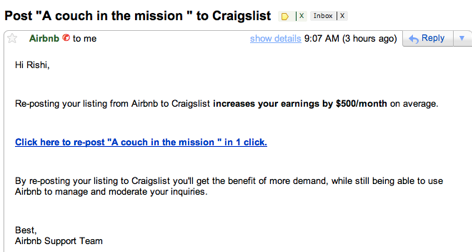
The bot also filled out a handful of forms, inputting the proper Craigslist category and region and replacing the anonymous email assigned by Craigslist with a link to the Airbnb listing. To ensure that the listing stood out, the bot made the most of the platform’s limited HTML support during publishing as well. As Andrew Chen, a Silicon Valley growth expert, explains: “This kind of integration is not trivial. … [I]t could only have come out of the mind of an engineer tasked with the problem of acquiring more users from Craigslist.” [7]
With the integration, Airbnb had unfettered access to Craigslist’s massive audience. To boot, the Airbnb listings were far superior to the other properties available—with more personal descriptions and nicer photos—which made them more appealing to Craigslist users. Curious Craigslist users hopped over to Airbnb in droves, and the rest, as they say, is history. [7] While the integration violated the terms of service for Craigslist and automated posting, many view this technical workaround a piece of ingenious engineering and marketing. This “growth hack” has become a thing of Silicon Valley legend, with it used as an example of what can be when marketing and engineering work together, as well as a cautionary tale of drifting into murky ethical decisions when it comes to growth.
Airbnb Gets Greedy on Craigslist
While the first integration got much needed traffic to Airbnb listings fromCraigslist the company saw another opportunity for getting more users to list their properties on Airbnb in the first place. This time, Airbnb went from clever to spammy, trying to get the most out of the platform. Dave Gooden, who works in the vacation rental sector, says that in late 2009 he began looking into Airbnb’s mysterious growth. He explains: “In my AirBnB research, … I couldn’t find any rational or traditional reasons for this type of growth. All of these AirBnB users can’t be coming from tech blogs, can they? Word of mouth? I didn’t think so. After thinking on it for a day or two, only one possible answer popped into my head: ‘These guys are black hats!’” [50]
To test his theory that Airbnb was spamming the service to attract users, Gooden set up a “mouse trap” on Craigslist. Within a couple of hours, Gooden says he received an email from a “young lady” who really liked his property and wanted him to check out Airbnb. To make sure it wasn’t just an earnest fan, he listed additional properties, each time receiving similarly worded messages. As Gooden explains: “When you scale a black hat operation like this you could easily reach tens of thousands of highly targeted people per day…I am pretty sure that AirBnB isn’t the only company that has used this strategy/technique, but I think they are the first to turn it into a one hundred million dollar investment at a one billion dollar valuation.” [50]
Though this hack isn’t as elegant as the first Craigslist platform integration discussed above—and it and it definitely constitutes spam—it certainly helped Airbnb to grow their listings quickly and at almost no cost. And while the company was eventually shut out of Craigslist, their traction had already been cemented.
Opportunistic Growth at Every Turn
Craigslist shenanigans aside, Airbnb’s focus on the customer is a continual spring of new ideas that unlocked new growth. In the summer of 2009, Airbnb wasn’t gaining much traction in New York, so Gebbia and Chesky flew out and booked spaces with 24 hosts to figure out what the problem was. As it turned out, users weren’t doing a great job of presenting their listings. According to Gebbia, “The photos were really bad. No one was booking because you couldn’t see what you were paying for.”
Their solution was low-tech but effective. The pair rented a $5,000 camera and went door to door, taking professional pictures of as many New York listings as possible. The new photos resulted in two to three times as many bookings on New York listings [2], and by the end of the month Airbnb’s revenue in the city had doubled.
What was stunting growth in New York was also stunting growth in Paris, London, Vancouver, and Miami.[4] This led to the Airbnb photography program, which launched in the summer of 2010. Hosts could automatically schedule a professional photographer to come and photograph their space.[4] Though this initiative wasn’t cheap, the enhanced listings from this program are two and half times more likely to be booked, and they earn their hosts an average of $1,025 per month— they were well worth the cost.
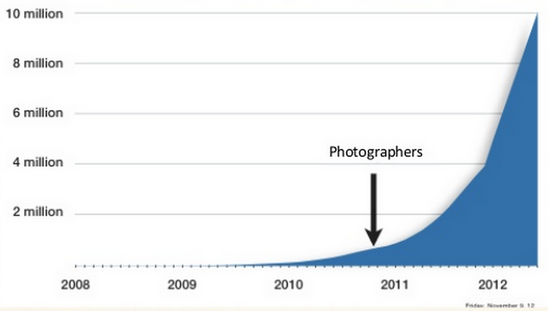
No detail escaped that type of applied learning and optimization, right down to the small matter of saving favorite properties on the site. In this case, the team decided to test changing the generic star icon users used to save a property to a heart, and they were surprised to when engagement increased by 30% as a result of that simple change.
The company tests things big and small, including their international expansion strategy. In August of 2014, Airbnb’s Rebecca Rosenfelt gave a talk entitled “Going for Global,” in which she outlined some of the company’s international growth strategies, including a test in France to determine the optimal way to launch new international cities. Airbnb randomly selected half of the international launch cities to physically visit, and half to target using Facebook ads. [51]
Airbnb kept meticulous track of what it cost to send people and the listings that resulted, and compared that to the Facebook ads and resulting listings in the markets they didn’t visit. It turned out that cost per acquisition was 5x better for actually sending people into markets. Not only that, but after “kickstarting” these markets with a human presence, they kept growing 2x faster by themselves.
Yet another example of their scientific approach to growth is the work the company has done to maximize opportunity on mobile devices, including giving users the ability to invite new friends to Airbnb. By October of 2013, around 50% of hosts were using the mobile app [34], and those hosts tended to respond to guests three times faster than those on desktop. [36] As Chesky explains, “Can you imagine if every Uber driver had to go home first to check their laptop in order to find their next ride?” [24]
In late 2013, Airbnb decided to relaunch their “underutilized and underperforming” [53] referral program. Gustaf Alströmer, Growth Product Manager at Airbnb, describes the referral system as something they weren’t proud of. After 3 months and 30,000 lines of code, Airbnb’s referrals program relaunched in January of 2014. As you would now expect, they immediately A/B tested all kinds of variables to learn as much as possible. It turned out that invites with a photo of the sender helped to reinforce that feeling. Another A/B test involved the promotional emails sent by Airbnb to potential referrers. When testing self-interested versus altruistic language, they found that altruistic emails resulted in more invitations sent globally. [53]
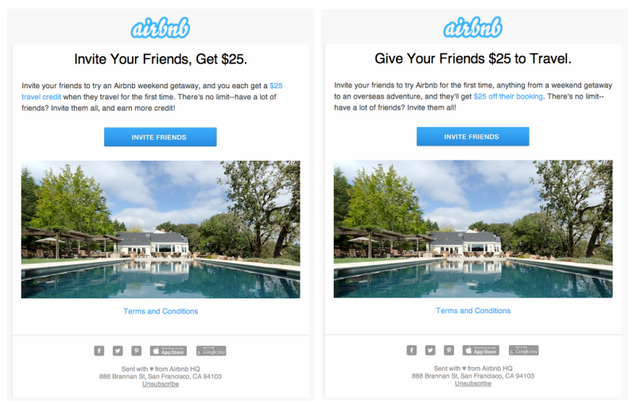
Airbnb’s new referrals program resulted in hundreds of thousands of nights booked by referred users in 2014,[52] and referrals increased booking as much as 25% in some markets. [53] Airbnb found that referred users tend to be better than the average user—in other words, they’re not merely in it for a free night. They tend to remain engaged with Airbnb and book future trips, and they are much more likely to send referrals themselves.
Dodging Controversy
Airbnb has not been without it’s stumbles and controversies. From nearly the beginning, the company has battled both renter and guest abuse, theft, and a raft of legislative issues from government and special interest groups. Airbnb has survived many of these issues primarily through its mostly proactive approach to resolving them. Airbnb has scaled their customer support staff, create a dedicated Trust & Safety department, a Host Education Center with safety tips for hosts, design enhanced userprofile verification, facilitate richer communication between guests and hosts pre-booking, and offer insurance options to hosts—a $1,000,000 Host Guarantee. Thanks to these measures the safety and liability concerns of 2011 are less of an issue for Airbnb, although the stories of wild Airbnb guests continue to be hits in the press.
Only July 16, 2014, Airbnb officially relaunched their site and mobile apps with an entirely new look and feel which Chesky claims he was able to distill it all into a single concept—belonging. He explains, “Airbnb is about belonging anywhere. The brand shouldn’t say we’re about community, or our international [reach], or renting homes—it’s about belonging.” [47]
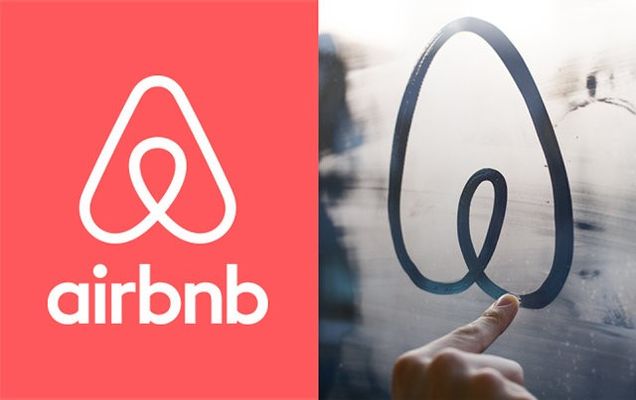
But the Bélo, the company’s nickname for its logo, hasn’t been received with excitement and positivity all around. Some have noted that it seems to be a ripoff, [48] while others—in particular, a Tumblr that was started the same day as the redesign—have made more crass comparisons to genitalia. [49]
The company’s biggest concern isn’t their logo, however, it’s dealing with blowback from the hotel industry, along with city and state officials—both of whom aren’t quite sure what to do when it comes to taxing and regulating Airbnb transactions. The hotel industry in New York City has been particularly outspoken about their disdain and concern over Airbnb. The company’s home base of San Francisco is also in the midst of redefining and regulating the laws governing short-term rentals. This back and forth between the hotel industry, state and local government, and landlords—all of whom want their share of the action—will be Airbnb’s biggest struggle as it seeks to deliver on its brand promise and continue to grow.
As Chesky explained to Fast Company in early 2014, “Our business isn’t [renting] the house—our business is the entire trip.” [23] As Paul Graham explains, “If you ask Brian now what drives Airbnb’s growth, it’s not that people want to get a cheaper space. Airbnb could’ve spread out horizontally into the sharing of power tools and cars and stuff like that. But Brian has decided the growth is in hospitality.” [24] This focus lead to the hiring of Chip Conley, who joined the company out of semi-retirement after 24 years as CEO of Joie de Vivre. Conley, now Head of Global Hospitality at Airbnb, has become one of Chesky’s most trusted advisers.
Now flush with cash, a growth engine that shows no signs of slowing, and an emerging brand, the future of Airbnb is much of what it makes of it. Will they be able to navigate the city-by-city regulatory hurdles to become an iconic hospitality brand? Or will the missteps catch up to them and ultimately upend the promise of the shared economy promised by Airbnb? It will be a saga that will play out over the next handful of years; but one thing will be certain–the Airbnb team will be experimenting and optimizing their way through it to the end.
 Morgan Brown is the COO of
Morgan Brown is the COO of
2 comments
Great article on the rise of Airbnb. We are without a doubt feeling Airbnb’s presence here in NYC at the hotel level from a operational and financial standpoint. The landscape of the hotel industry is changing and it is somewhat unsettling for us hoteliers.
Amazing article! Personally, I used to order Airbnbs much more in early days(going on hunting and fishing trips across US, those came in very handy, basically a good place to drop my rods and hunting gear while I go shopping for stuff like 223 ammo ). But now quality went down drastically as more people hopped on the franchise. I’d say that 3 out of 5 orders I did this year were really low quality…